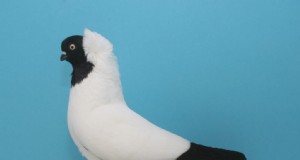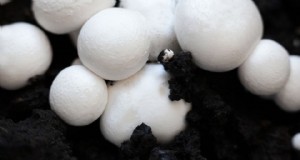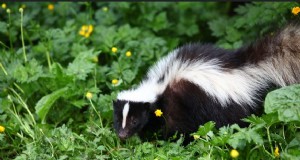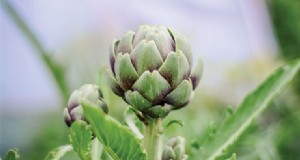A I r - B recitando F es h C ultu re
Los méridos y los peces gato son conocidos por su estima y buena demanda en el mercado debido a su bajo contenido en grasas y pocas espinas intramusculares. Los peces que respiran aire son resistentes y capaces de respirar aire atmosférico con sus órganos respiratorios accesorios. Debido a la presencia de estos órganos respiratorios accesorios, estos peces pueden sobrevivir durante algunas horas fuera del agua. Estos órganos respiratorios accesorios son árboles respiratorios en Clarias , órgano laberíntico en Channa , vejiga de aire en Heteropneustes , cámara branquial en los peces anteriores, etc. y son capaces de absorber aire. Estos se pueden cultivar en áreas de bajo oxígeno disuelto, como aguas poco profundas y fétidas, estanques y pantanos abandonados. Debido a su capacidad para vivir fuera del agua, su cultura implica un bajo riesgo y una gestión sencilla.
En India, Andhra Pradesh, Assam, Uttar pradesh, Madhya Pradesh, Tamilnadu, Karnataka, Maharastra, Bihar y Meghalaya apoyan la pesquería natural más importante de peces que respiran aire. Estos peces son carnívoros por naturaleza y se adaptan excelentemente a la alimentación complementaria. Como no hay mucho desperdicio de energía a través de la respiración por los crecientes respiradores de aire de las aguas poco profundas, cabe esperar buenos rendimientos.
Las especies cultivables de peces que respiran aire son Fig. 9.1
C h a nn a s t r a eso tu s - Pez murrel o cabeza de serpiente grande o rayado
C Hann a punctatu s - murrel manchado
Channa marulius - Murrel gigante
Clarias batrachus - Magur
Heteropneustes fossilis - Singhi
Anabas testudineus - Koi o percha trepadora.
Fuera de estos Channa estriado tiene la mayor demanda en los mercados y también tiene un precio más alto. Los siguientes mejores son Clarias y Heteropneustes . El cultivo de las especies mencionadas es rentable.
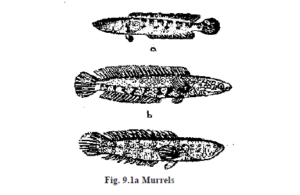
a) Channa marulius b) Channa straitus c) Channa punctatus
Cu l turab l mi zona s
El cultivo de peces que respiran aire necesita aguas poco profundas con una profundidad de 50 a 75 cm. Los estanques para el cultivo de peces que respiran aire no necesitan ser fertilizados con productos químicos. Los peces que respiran aire también pueden cultivarse en jaulas en sistemas de agua corriente como arroyos, canales y aguas incontrolables como embalses. El cultivo de peces que respiran aire es igualmente adaptable en aguas inadecuadas para especies de carpas cultivables convencionales, así como en estanques de cultivo de carpas. Los estanques poco profundos son útiles para los peces, en el que el pez tiene que gastar menos energía para viajar a la superficie para ingerir oxígeno atmosférico.
Ver D colección norte
La semilla del murrel, magur y singhi se obtienen de los recursos naturales, a pesar del éxito logrado en la cría inducida. Incluso hoy, la semilla recolectada de la naturaleza sigue siendo la fuente más confiable de material para la siembra. Se sabe que los murrel alcanzan la madurez en dos años y se reproducen durante todo el año. Los alevines de 2-4 cm se pueden recolectar durante todo el año y en acequias de secano y cuerpos de agua poco profundos con abundante maleza. Sin embargo, se sabe que el pico de desove ocurre justo antes de los monzones.
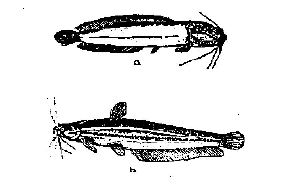
a) Clarias batrachus b) Heteropneustes fossilis
Las crías que emergen de los huevos se mueven en cardúmenes y su recolección en grandes cantidades siempre es fácil. Es posible que los alevines no tiendan a moverse en cardúmenes. Los alevines de murrel gigante se pueden identificar por su cuerpo gris oscuro y una banda lateral de color amarillo anaranjado desde el ojo hasta la aleta caudal. Los alevines de murrel despojado tienen el cuerpo rojo brillante con una banda dorada rojiza y una banda negra oscura desde el ojo hasta la aleta caudal. Los alevines múridos manchados pueden reconocerse por su cuerpo de color marrón oscuro con una banda lateral de color amarillo dorado y una línea amarilla dorsal media en el dorso.
En la cultura murrel, Es mejor sembrar alevines en lugar de alevines. El canibalismo se encuentra en alevines de murrel. La tasa de supervivencia de los alevines producidos por la cría inducida será baja y es difícil mantener el desove y hacerlos crecer hasta la etapa de alevines. Los huevos no comen nada durante dos días después de su salida de los huevos. Por eso, los alevines deben estar entrenados para aceptar alimentos suplementarios en estanques separados. El pienso complementario consiste en huevos duros, pupas de gusanos de seda, Pescado y gusanos picados junto con levadura y vitamina B.
Se administra durante unos 15 días a razón del 20% de su peso corporal total. Los alevines alcanzan la etapa de alevines de 4-6 cm de longitud en un mes.
Los peces gato se reproducen dos veces al año con la temporada alta de reproducción durante la temporada de lluvias. Los alevines de Magur se pueden identificar por su aleta dorsal más larga y su color pizarra. Los alevines de Singhi tienen una aleta dorsal corta y un color rosado. Los alevines de koi se pueden identificar por la mancha oscura en el pedúnculo caudal y el tono verdoso en la superficie dorsal del cuerpo. Los magurs hacen un agujero de 25 cm de profundidad en el haz debajo de la superficie del agua. Los huevos fertilizados se adhieren a la hierba y son custodiados por los machos. 2, 000 - 15, Se pueden recolectar 000 alevines de cada hoyo con la ayuda de pequeñas redes manuales de malla fina y criarlos en viveros hasta que alcancen la etapa de alevines con unos 5 cm de longitud.
Magur se puede cultivar en estanques para la producción de alevines. Se hacen compartimentos de malla de alambre de 1 x 1 m en los márgenes del paquete. En el centro de cada compartimento, Se cava un hoyo de 30 cm de diámetro y está provisto de pocas plantas acuáticas. Después de liberar a ambos sexos, como 5, Se pueden recoger 000 alevines de cada compartimento en un plazo de 10 días. Los machos y las hembras también se pueden criar en pequeños estanques de tierra. Se pueden almacenar 20, 000 / estanque y se alimentan con zooplancton filtrado o harina de pescado picada y torta de aceite de cacahuete. Los alevines se pueden criar durante 15 días en viveros.
La temporada alta para la recolección de semillas de singhi es el período anterior al invierno, cuando se cosecha el arroz y los campos bajos quedan expuestos.
Ver D tr a nspor t
Los alevines o los alevines de los peces que respiran aire pueden transportarse sin empaque de oxígeno. Los tambores de polietileno o de hierro se utilizan para el transporte de alevines o alevines. El portaaviones debe tener suficiente espacio para que su superficie habitual respire aire atmosférico. El transportador debe tener una pequeña cantidad de malezas acuáticas como Vallisneria, Hydrilla , Myriophyllum y Ceratophyllum . Las malas hierbas pueden ayudar a evitar que los peces salten durante el transporte. Si la distancia es mayor es mejor transportarlos en contenedores de polietileno envasados con oxígeno.
Pon D mamá norte ageme norte t
Los viveros miden entre 10 y 15 m2, teniendo una columna de agua de 50 cm. Estos se siembran con 0,2 - 1,5 millones de alevines / ha. Antes de almacenarlo, El abono se realiza con estiércol crudo de ganado a razón de 500 kg / ha solo. La emulsión de jabón y aceite para erradicar insectos se aplica al agua del vivero. Los alevines y alevines de magur y singhi recolectados de recursos naturales requieren manejo de vivero, pero los murrel tienen que ser entrenados en estanques de crianza antes de la siembra. Después del manejo del vivero, los alevines se trasladarán a estanques de siembra.
Stoc k en gramo
Se eligen alevines de tamaño uniforme para la siembra. Los alevines se desinfectan con una solución de KMNO4 al 2% durante 5 minutos o se sumergen en una solución de formalina a 200 ppm durante 50 segundos antes de la siembra. Los alevines heridos se tratan con acriflavina al 0,3% durante 5 minutos.
Estos peces pueden escapar trepando o excavando. Por eso, los terraplenes del estanque deben ser firmes con troncos o madera pesados, o vallado con caña de bambú o mallas de alambre hasta una altura de unos 50 cm.
Se pueden sembrar más alevines en su sistema de cultivo. 40, 000-60, 000 sistemas.
alevines / ha de peces gato se pueden sembrar en monocultivo En sistemas de policultivo 20, 000 - 30, 000 alevines / ha de gato
se pueden almacenar peces. En sistemas de monocultivo, 15, 000 alevines / ha de murrel gigante, 20, 000 / ha en caso de murrel rayado y 20, 000 - 30, 000 / ha en caso de siembra de arao manchado. En sistemas de policultivo, El murrel rayado y manchado se puede sembrar a una tasa de 20, 000 alevines / ha en una proporción de 1:1.
El policultivo de murrel - carpas y bagres - carpas también es posible con el cuidado y manejo adecuados. La semilla de los peces que respiran aire debe almacenarse solo cuando las carpas hayan crecido a un mínimo de 300 gr. para que los peces que respiran aire no se aprovechen de las carpas. Con este, no solo se puede obtener un ingreso adicional mediante la producción de peces que respiran aire, pero también se puede potenciar el crecimiento de las carpas. Cuanto más tarde es posible, como los peces basura que pueden competir con las carpas por comida y espacio, son erradicados por los crecientes respiradores de aire.
Alimentar gramo
Para mantener un suministro abundante de alimentos para los que respiran aire en crecimiento, el estanque de repoblación debe ser rico en fuentes de alimento animal como renacuajos de rana y peces basura. Si esta fuente de alimento no es suficiente, la tilapia también se puede cultivar en estanques de peces murrel y gato. El pescado seco de basura marina también se utiliza en el cultivo de peces y es más económico. Se puede alimentar a los bagres con despojos de pescado o desechos del matadero o crisálidas de gusanos de seda secas mezcladas con salvado de arroz y tortas oleaginosas en una proporción de 1:1:1:1. Una mezcla de tortas oleaginosas, El salvado de arroz y la suspensión de biogás en una proporción de 1:1:1 han proporcionado un alimento exitoso a bajo costo para singhi. El salvado de arroz y el pienso de aves de corral en 3:1 y la suspensión de biogás y el salvado de arroz en 1:2 también se administrarán en una proporción del 5 - 8% del peso corporal.
Durante los ocho meses de cultivo semi-intensivo en estanques estancados, la población de bagre que respira aire puede alimentarse a la siguiente tasa diaria durante las horas oscuras del día para obtener una mejor utilización del alimento (Tabla 9.1).
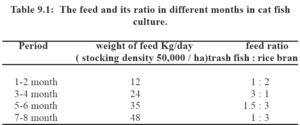
El alimento puede esparcirse en el estanque en pequeñas cantidades del paquete o puede ser servido en cestas de alimento bajadas cerca del banco además de esparcir el alimento para asegurar la disponibilidad de alimento para todos los peces en el estanque. Las trampas de luz se pueden instalar en estanques de murrel, por lo que los insectos pueden ser atraídos por la luz y utilizados por los murrel como alimento rico en proteínas.
Los alevines de murrel entrenados también aceptarán peces de basura marina secos y baratos empapados en agua, que se puede proporcionar según el siguiente programa de alimentación (Tabla 9.2). También se pueden utilizar los desechos de los mataderos y las pupas de gusanos de seda como fuente de proteína animal.
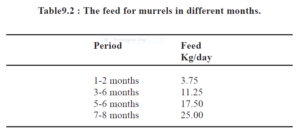
Gramo o peso h a norte D pag r sobredosis tu Connecticut I o norte
Los murrel y los peces gato alcanzan un tamaño comercial en un período de meses respectivamente. Si las prácticas de manejo son adecuadas, los murrel gigantes y rayados pueden alcanzar un crecimiento de 1 a 2 kg / año. y 0,75 kg / año. respectivamente, mientras que los murrel manchados crecen hasta 160 gr. en 8 meses. Se sabe que los peces gato crecen lentamente en comparación con los murrel. Magur y singhi crecen a 0,2 kg y 0,1 kg respectivamente. La tasa de conversión con el alimento recomendado es de aproximadamente 2:1.
Los mérculos con peces forrajeros como alimento complementario rinden alrededor de 4 toneladas / ha / año. Magur con pescado de desecho seco y pienso complementario de salvado de arroz, dan una producción de 10 toneladas / ha / año. Singhi da un rendimiento de 4,4 / tonelada / ha / año. Policultivo de murrel y koi, alimentado con salvado de arroz, torta de aceite mustared y pescado basura, dar una producción de 11,8 toneladas / ha / año, mientras que magsur y singhi alimentados con salvado de arroz y peces de desecho dan un rendimiento de 5 toneladas / ha / año. El cultivo mixto de 3 especies de murrel produce 4 toneladas / ha / año cuando se alimenta con peces de basura marina remojados y secos y pupas de gusanos de seda frescos como alimento. En el cultivo intensivo magur puede dar 7 toneladas / ha / 5 meses.
C ul t tu mi w I t h California r pag s
Con una densidad de población de 5000 / ha de carpas indias y chinas y 1000 alevines de magur producen 2518 kg / ha / año de carpas y 3711 kg / ha / año de magur. Esto indica que el policultivo es más rentable, y es útil incluir magur en el sistema de cultivo de carpas. Con una densidad de población de 20, 000 / ha de magur junto con las carpas sobrantes (después de la recolección parcial de carpas) se obtiene una producción de 3.96 toneladas / ha / año con una proporción de 50:30:17:3 de salvado de arroz, comida de pescado, torta de aceite de cacahuete y minerales como pienso complementario. El magur se considera adecuado para el cultivo de peces compuestos de carpas en lugar de carpa común. Magur, koi y singhi también son adecuados para el cultivo junto con una makhana de carpa de alto precio, Euryale ferox .
Har v estin gramo
La temporada de verano es ideal para recolectar aire:peces que respiran de los estanques. El estanque se drena y los peces se recolectan con la ayuda de redes de pala o de mano. Debido a su alta demanda y precio de mercado, el cultivo de estos respiradores de aire proporciona ingresos rentables a los piscicultores con técnicas de gestión sencillas.
C a gramo mi culto tu r mi
Los respiradores de aire también se pueden cultivar en jaulas. Las jaulas se preparan con esteras hechas de bambú partido en agua corriente. El área óptima de la jaula mide 2 mx 1 mx 1 m de tamaño. La parte superior de la jaula se cubre a la mitad con un tapete y la parte descubierta se cubre con una red para facilitar la alimentación y evitar el escape de los peces. La malla de fibra sintética también se usa para preparar jaulas.
Magur se siembra a razón de 200 / jaula, alimentado con un 10% del peso corporal de pescado seco de desecho, torta de aceite y salvado de arroz y producen 10 - 12 Kg / m3 / año. Singhi produce 12-20 kg / m3 / año con una densidad de población de 100-150 / jaula y 10% del peso corporal se alimenta de pupas de gusanos de seda. torta de salvado de arroz y aceite de mostaza. Koi produce 4,2 kg / m3 / año con una tasa de carga de 50 a 100 / jaula con la misma comida que singhi. El murrel manchado produce 4 Kg / m3 / año con pescado de desecho y salvado de arroz. Por eso, la piscicultura que respira aire es muy rentable, así como una rica fuente de proteína animal. Este pescado se considera un delecado, y tiene un precio muy alto y una demanda continua en los mercados.
T R UNED T CU L T UR mi
La trucha se cultiva como pescado para consumo humano o como pescado deportivo, se liberan en aguas naturales para pescadores deportivos. La trucha es popular porque es un atractivo, Pez luchador activo y proporciona una carne de muy alta calidad. Se han liberado y cultivado truchas en el agua en todo el mundo. Las truchas se han cultivado a escala comercial en EE. UU. Desde hace mucho tiempo. Su cultura en Europa se remonta a 400 años. Es un pez de agua fría. Habita principalmente ríos, arroyos, Arroyos, lagos y estanques. En India se encuentra en Cachemira, Himachal Pradesh, Uttar Pradesh, Nilgiris, Colinas de Kodai y alta gama de Munnar.
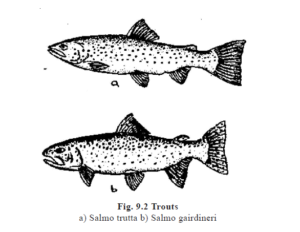
Se cultivan muchas especies de truchas, pero las tres más comunes son la trucha arcoíris, Slamo Gairdneri o Oncorynchus mi beso, la trucha marrón euroreana, S.trutta (Fig. 9.2) y la trucha de arroyo, Salvelinus fontinalis. Las truchas tienen un cuerpo aerodinámico, aberturas branquiales estrechas y branquias reducidas. Las truchas están adaptadas a aguas altamente oxigenadas y temperaturas de punto de congelación. Las truchas tienen un gran poder de locomoción con hábitos de agarre y madriguera. La boca se modifica con labios ásperos para la recolección de alimentos de los guijarros, rocas etc.
S pag aw norte en gramo
La temporada de desove de S.gairdneri es de septiembre a febrero, S.trutta es de octubre a diciembre y S.fontinalis es de octubre a enero. Las truchas prefieren el sustrato de grava para proteger sus huevos y los huevos se adhieren a la grava y los escombros. Las truchas construyen nidos y desovan en los lechos de los arroyos. Los cultivadores permiten la fertilización artificial, porque la fertilización del lecho de los arroyos da como resultado una tasa de eclosión menor que la fertilización artificial. La manipulación del fotoperiodo y la temperatura del agua se puede utilizar para inducir la maduración gonadial, para que se generen alevines durante todo el año. Las truchas se capturan en la madurez o cerca de ella, ya que nadan río arriba y se crían hasta alcanzar la madurez en estanques. Los peces reproductores se colocan en pequeños estanques con agua corriente y, a menudo, se cubren con redes para evitar que salten. La lecha de un solo macho se puede utilizar para fertilizar dos hembras, para que haya más hembras con pocos machos.
Las truchas presentan dimorfismo sexual. Los machos adquieren colores más brillantes y la mandíbula inferior desarrolla un pico en forma de gancho durante la temporada de reproducción. Las hembras desarrollan vientres extendidos y la papila genital se vuelve más grande y rojiza. Cuando estén completamente maduros, la leche o los huevos salen con poca presión sobre la ventilación abdominal. Cuando la trucha esté madura, las hembras se despojan y los huevos se recogen en un recipiente de plástico o esmalte de color negro al que se añade la lecha del macho y se mezcla a fondo con una pluma para la fertilización. Se agrega agua después de mezclar y el agua hace que los huevos se hinchen. No se debe agregar agua antes de la mezcla, ya que la motilidad de los espermatozoides se reduce considerablemente en presencia de agua. Para garantizar una mejor tasa de supervivencia, los huevos se pueden recoger en una pequeña cantidad de solución salina (10 litros de agua dulce + 90 gr. de sal común + 2 gr. de cloruro de potasio + 3 gr. de cloruro de calcio). Los huevos fertilizados adquieren un tinte verde y se conocen como "verdes", que luego se transfieren a los criaderos. Antes de transferir, elimine las partículas extrañas y los huevos muertos.
T real academia de bellas artes ns pag o r t a I o norte o F t derrota mi gg s
Los huevos fecundados y endurecidos (endurecidos durante 24 horas) de trucha se transportan en cajas de cartón de tamaño 20 X 30 X 20 cm. El lado interior de la caja de cartón está forrado con un forro de espuma de poliestireno. Se colocan dos esponjas húmedas o almohadillas de algodón, uno en el lado inferior y otro en el lado superior. Bolsas de polietileno poroso que contienen aproximadamente 4, Se colocan 000 huevos entre las esponjas húmedas y las almohadillas de algodón. Se guarda una bolsa de polietileno con hielo roto IKg para mantener baja temperatura, por encima de la almohadilla superior. Estas cajas de cartón se transportan a varios lugares.
Nacedora y tec h nique s
Los huevos de trucha se incuban manteniéndolos en comederos de hormigón con bandejas planas y dispuestas horizontalmente, incubadoras o jarras. Los criaderos deben contar con agua dulce circulante filtrada y libre de sedimentos. Antiguamente se usaban cestas para la incubación. Las incubadoras de flujo vertical son las más comunes. Tiene muchos aceros inoxidables, de fibra de vidrio, aluminio, o madera, o PVC, o bandejas de plástico, dispuestas una encima de la otra. El fondo de las bandejas está provisto de láminas de zinc perforadas, rejillas de vidrio o tela de rejilla para asegurar el paso del agua por las diferentes bandejas. El tamaño puede variar de 180 X 30 X 10 cm a 500 X 100 X 50 cm. Cada bandeja tiene una cesta de huevos superior y un compartimento perforado inferior sobre el que descansa la cesta. Los huevos se colocan en la canasta para su incubación. El agua se introduce en la bandeja de tal forma que fluya hacia arriba a través de la cesta que contiene los huevos, luego hacia abajo a la bandeja de abajo y hacia arriba a través de esa canasta y así sucesivamente a través de la incubadora. Este flujo ascendente de agua a través de los huevos permite una mayor aireación y facilita la eliminación de metabolitos.
Los frascos para incubar también se utilizan para la incubación de huevos de trucha. Consiste en una pantalla galvanizada de malla de 0,5 mm con lecho de grava en la parte inferior, justo encima de la entrada. Este lecho de grava es útil como filtro para eliminar las partículas no deseadas. Los huevos se colocan sobre el filtro para incubar. El agua pasó por la entrada, surge a través del filtro y los huevos y se drena a través de la salida. Después de la eclosión, las crías se mantienen durante algún tiempo en los frascos.
Los huevos son muy sensibles durante el período de eclosión. Los huevos recién fertilizados pueden morir si se exponen directamente a la luz solar. Durante la incubación, el agua debe estar en movimiento y tener un alto contenido de oxígeno. La incubación se realiza normalmente en agua con una temperatura de 8 ° -12 ° C. Los alevines se pueden mantener en las bandejas hasta que se activen y puedan comenzar a alimentarse. Se pueden liberar para repoblación en aguas naturales.
Cu l tu re o F t rou t s
Los alevines se crían en pequeños comederos de cría antes de que hayan absorbido completamente su saco vitelino. e introducir a vivir con alimentos artificiales. Luego se transfieren a estanques de cría para su crianza hasta la etapa avanzada de alevines. Los estanques de cría pueden ser de hormigón o paredes de piedra con un tamaño de 2.5 X 1 X 0.75 ma 9 X 1 X 0.75 m. El flujo de agua se puede mantener a 100 l / min. dentro del estanque de cría.
Los alevines avanzados se crían hasta adultos en estanques de cría y canales. El estanque de cría es un cuerpo de agua natural, y una pista de rodadura es simplemente un estanque de peces de agua corriente. El tamaño de las pistas de rodadura debe oscilar entre 20 y 100 m2 con una profundidad de 1,5 m. Se construyen una serie de canales a ambos lados del arroyo o del río. Cada canal recibe agua del arroyo y el agua sale del canal a través de la salida que se encuentra en el lado opuesto. Las pantallas de placa de zinc se utilizan en entradas y salidas. El flujo de agua se mantiene a 50 l / s, en los estanques del río. En EE. UU. Se utilizan estanques circulares y ovalados. La carga animal puede limitarse a una producción de 5 a 10 kg / m2. También es posible una alta producción de 200 Kg / mis en pistas de rodadura, si la gestión es buena.
El cultivo de truchas en jaulas también es común. En un experimento Los alevines se sembraron a 1,4 kg / m2 en jaulas y se alimentaron 3 % de su peso corporal al día. Estas truchas crecieron hasta 27-88 gr. en dos meses. El alimento que se da a las truchas incluye bazo de ganado, corazón y pulmón y peces de basura marinos o de agua dulce. Muchos piensos comerciales para truchas están disponibles en el mercado. Las truchas se alimentan de 3 a 4 veces al día. Hay varias formas de alimentar a las truchas. El alimento se rocía sobre la superficie del agua, o el alimento se puede guardar en una bolsa o en un recipiente en la esquina del estanque. Se utiliza para los alimentadores de demanda, en el que cada vez que una trucha choca contra el gatillo, el alimento se libera en el agua, o también se pueden utilizar alimentadores automáticos. También se utilizan tarros y tambores para la cría de alevines de trucha.
Se w ag mi - Fe D F I s h Cu l tu re
Las aguas residuales son turbias, Fluido sucio y oloroso de nuestros baños y cocinas de nuestras casas. Tiene minerales y nutrientes orgánicos en estado disuelto o disperso en estado sólido. La eliminación de aguas residuales se ha convertido en un problema mundial debido a la urbanización. Es un efecto de demophora, es decir, un crecimiento constante de la población humana. En años recientes, las aguas residuales se han convertido en un importante contaminante de las aguas continentales, especialmente los ríos. Es fuente de muchas epidemias. Es responsable de una seria amenaza para los ecosistemas del suelo y el agua. El enfoque hacia la eliminación de aguas residuales debe ser la utilización de este residuo con el concepto de su reutilización o reciclaje a través de un sistema ecológicamente equilibrado que involucre principalmente la acuicultura. La utilidad de las aguas residuales para mejorar la fertilidad de los estanques de agua dulce se conoce desde hace mucho tiempo en muchos países del mundo.
La cantidad de aguas residuales producidas es India en 3,6 mm3 / d (millones de metros cúbicos por día) u 800 mg / d (millones de galones por día). Aproximadamente el 30% (1,9 mm3 / d) se produce en los centros urbanos. En estos centros solo se tratan 1,3 mm3 / d (20,4% del total de un día de la India). Casi el 80% del total de un día del país aún queda por tratar y utilizar. La cantidad de estiércol que se obtiene de la producción de aguas residuales en un día en la India es de aproximadamente 0,126 millones de toneladas. Esto equivale a 46 millones de toneladas / año. El estiércol de las aguas residuales de un día es suficiente para cultivar 0,1 m. De hectárea de cosecha anual de peces. Las aguas residuales también son útiles para cultivar peces. En la India, solo se encuentran más de 130 granjas de peces alimentadas con aguas residuales que cubren un área de 12, 000 hectáreas. Las pesquerías de Vidyadhari alimentadas con aguas residuales cerca de Calcuta son un ejemplo, donde los pescadores han aprovechado al máximo los sistemas de alcantarillado de Calcuta. Aquí el rendimiento de pescado es de aproximadamente 1, 258 Kg / ha. La alta capacidad de abono se combina con la potencialidad de servir como una fuente adicional de agua para el cultivo de peces y mejorar la producción de peces.
Co metro posi t io norte o F sewa gramo mi
La composición de las aguas residuales varía de un lugar a otro y según la temporada. El agua es un componente principal de las aguas residuales (99%) y la suspensión sólida en las aguas residuales asciende solo al 1%. En promedio, las aguas residuales de las ciudades indias contienen 52 ppm de nitrógeno, 16 ppm de fósforo, 45 ppm de potasio y 350 ppm de materia orgánica biodegradable. El componente de carbono orgánico es de 25 a 40 ppm, siendo la proporción de carbono y nitrógeno 1:3. Salts of several heavy metals such as Zn, Ni, Cr Pb, etc. are also found above the permissible levels in sewage. The organic refuses in the sewage have proteins, carbohydrates and fats in varied proportions depending on the nutritional status and food habits of the population. Among carbohydrates, readily degradable starch, sugar and cellulose are detected.
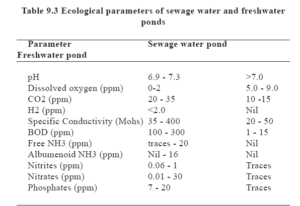
Some ecological features of different waters are mentioned in Table 9.3. Sewage water has high BOD (Biological Oxygen Demand) and Oxygen Consumption (OC) values. Dissolved oxygen becomes depleted in sewage water due to high oxygen demand and low photosynthetic rate. Photosynthesis is low because of poor illumination as the suspended solids in sewage water obstruct sunlight. En promedio, fuerte, medium and weak sewage consist of 1200 ppm, 720 ppm and 350 ppm of total solids respectively, out of which 850 ppm, 500 ppm and 250 ppm occurs in a dissolved state and 350 ppm, 220 ppm and 100 ppm is found in suspended form. Dissolved salts being very high in sewage water, manifest high specific conductivity. Production of acids in high amounts render the water acidic, making the medium unfit for supporting life (Fig. 9.3). Acidity of water below pH4 is known to kill the flora and fauna.
Sewage enriches water with organic matter that begins to decompose aerobically thereby depleting dissolved oxygen and leading to anoxic condition. Anoxia causes non-mortality of animals, adding organic matter further to the already rich organic content. In the absence of dissolved oxygen the organic matter undergoes anaerobic decomposition as a result of which obnoxious gasses like H2S, CH3 and CO are produced. These gasses besides being toxic, react with water to form acids.
Immediate effect of sewage on the biota is eutrophication. Sewage water stimulates rapid growth of phytoplankton leading to an algal bloom followed by rapid increase in zooplankton. For utilizing sewage in aquaculture, the properties such as the concentration of dissolved and suspended solids, organic carbon, nitrogen and BOD are essential.
Micro B iolog I California l C harac t arist I C s
Harmless and even useful non-pathogenic bacteria are present in much greater numbers in domestic sewage as compared to pathogenic bacteria comprising mostly the intestinal microorganisms found in the community producing the waste. Usual load of coliform bacteria in raw sewage ranges between 108 and 109 MPN/100ml.
Si t mi s mi leer I o norte a norte D C onst r ucti o norte o F se w la edad- F mi D fis h lejos metro
Fish farm in the vicinity of an urbanized area has the scope to receive domestic sewage for the recycling of nutrients. Any area adjacent to a municipal sewage treatment plant is ideal for the location of a sewage-fed fish farm. The fish farm site should be at a lower level than the treatment plant so that the sewage can easily enter into the pond through a pipeline by gravity. The fish farm should have facilities of draining out water from the ponds.
The plan of the fish farm depends upon the source of the sewage, system of culture and topography of the land. Nearly 75% of the total area is converted into ponds leaving the rest for dykes and other purposes. Rectangular fish ponds of 0.3 to 1 ha are constructed with a slope of 1:3 for the embankment and maximum depth of 1.5m. Each pond should have proper drainage facilities.
The effluent is collected in a sump at the farm, from where the effluent is taken into the ponds through the distributing system. Additional arrangement is made to connect the pipelines with freshwater supply for emergency dilution.
S mi meneo mi tr mi a mi norte t
Sewage treatment is necessary to kill the harmful microbes, prevent anoxia, raise the pH to an alkaline level, increase photosynthesis, reduce organic content, etc. The treatment has to be inexpensive and one which induces in sewage water the conditions prevailing in a natural freshwater pond. Sewage is treated in following three ways – mechanical treatment, chemical treatment and biological treatment.
Mech a nica l t tratamiento:
Solids and organic matter are removed to a large extent by mechanical treatment, which involves flowing, dilution and sedimentation. Usually screening and straining of sewage it is done to remove the waste solids. The liquid and semisolid wastes are then
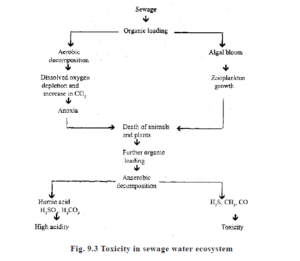
subjected to treatment for the removal of colloidal and semisolid suspension by dilution, H2S, CO2, CO, NH3, CH3 concentrations are brought below the normal levels. Por lo tanto, through primary treatment the supernatent effluent is separated from the sludge.
C h emic a l t tratamiento:
In chemical treatment, several dissolved substances, harmful germs and aggressive odours are eliminated. Inexpensive precipitants,
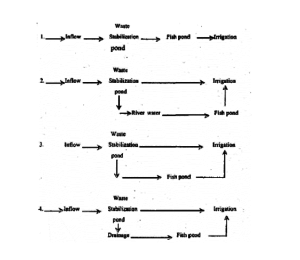
coagulantes, chelating substances, disinfectants, deodorising agents, etc. are used in this treatment. The sewage water is also treated with chlorine, bleaching powder and copper sulphate. It is also known as secondary treatment.
Biol o gica l t r mi atment :
In biological treatment of sewage care is taken to promote bacterial growth. Bacterial action promotes oxidation of organic matter. The end products nitrogen oxides, bring about rapid growth of algae, particularly the blue green Microcystis. This arrests anoxia of water by raising the dissolved oxygen, lowering the CO2 content and by increasing the pH from acidic to alkaline levels. The algal bloom reduces the concentration of dissolved salts in the sewage water.
Correos norte D Mamá norte ag mi hombres t
F mi rtil I Zati o norte
Fertilization of sewage-fed pond is done in two phases, pre-stocking and post-stocking fertilization. In dewatered and sun dried ponds, primary treated sewage effluent is taken up to a depth of 60 – 90 cm during premonsoon months (April – May). The effluent is then diluted with rain water or freshwater till the pond BOD reduces to 50 ppm. Periodic fertilization with sewage effluent is carried out after two months of stocking to maintain nutrient status and productivity of the pond at a desired level. The quantity of sewage effluent to be allowed into a pond solely depends on its quality determined on the basis of BOD values.
Limin gramo
Application of lime in sewage-fed ponds is most essential. It is a useful promotor of fertility in ponds and act as a disinfectant against harmful microorganisms. Prestocking liming is recommended at a rate of 200 – 400 Kg/ha as initial dosage. Subsequent liming of 150 – 200 Kg/ha on standing crop is necessary throughout the year during sewage intake and during winter months, when parasitic infection is more.
Stoc k en gramo
The cultivable species of freshwater fish such as Indian major carps and exotic carps can be grown in sewage-fed waters. Considering the high carrying capacity and high productivity of sewage-fed ponds with respect to plankton and benthic fish food concentration, fish are usually stocked at a reasonably higher density. The stocking rate recommended 10, 000 – 15, 000 /ha of carp fingerlings of about 10 gr. each and it is preferred to stock more of omnivorous scavengers and bottom feeders to maintain fish pond hygiene for higher yield. The ratio of carps for better output is rohu 2.5 :catla 1:mrigal 2.5 :common carp 2 :silver carp 2. Omnivores and bottom feeders directly consume the organic detritus of sewage-fed ponds, and thereby directly helping in keeping the pond aerobic. The stocking rate of fish is kept on a higher side considering the profuse growth of algae which will otherwise grow, decaer, putrify and finally deplete the oxygen concentration of fish pond.
mi C ologica l C onsideratio norte s un D a lga l cont r o l
Maintenance of aerobic conditions of the sewage-fed pond is highly essential and as such early morning dissolved oxygen level should not deplete below 2 ppm for carps. The BOD should be below 30 ppm for better survival of fishes. CO2 concentration should not be allowed to increase beyond 20 ppm to keep the toxicity level within tolerance limit for fish and to control algal blooms. Liming helps in regulating CO2. Heavy metal pollution, Si alguna, can be controlled by introducing water hyacinth at the pond margins and barricading them with bamboo poles to prevent spreading of the weed throughout the water surface of the pond.
Algal control is a must to maintain proper dissolved oxygen. It should be more than 2ppm and optimal 5 – 6 ppm in a sewage-fed pond. The presence of silver carp regulate the algae in the culture system. When biological control of algal bloom is not possible, application of simazin at rate of 0.5 – 1 ppm is recommended.
Estafa t ro l o F a q uat I C inse C t
Aquatic insects are found in sewage-fed ponds, especially more during winter months. The insects of the pond mainly comprises hemiptera, coleoptera, odonata, zygoptera and trichoptera. Dipteran insects dominate, especially the larval stages of Chironomids associated with annelid worms of tubificidae.
Other insect larvae of the sewage-fed ecosystem belong to tubanidae, anthomyiodae, tetanocoridae, etc. The predacious hemiptera, coleoptera and a few odonata, zygoptera are needed to be controlled. An emulsion of soap and vegetable oil at a rate of 4 Kg/ha and in the ratio of 1:3 is applied to control these insects.
H arvestin gramo un D yi mi l D
After 5 – 6 months culture, when the biomass grows to an optimal level, the stocking density is thinned out through periodical and partial harvesting. The water depth of the pond is reduced by dewatering for final harvest when the fishes are removed by repeated drag netting.
In a mixed culture of five carp species in sewage-fed ponds, the yield rate varies from 5.4 – 8.6 t/ha/yr with an average production of 7 tonnes/ha/yr. The fishes are around 500 gr. to 1000 gr. during culture operations.
The recurring expenditure on sewage-fed fish culture is meagre compared to that of fresh-water fish culture. This culture is lucrative and a fish farmer can obtain an income, on an average of more than Rs. 40, 000 /ha/yr. If murrels are cultured in oxidation ponds and the excess sewage is utilised for the cultivation of crops, the revenue could be further augmented.
Full utilization of sewage has manifold benefits. Outbreak of epidemics can be prevented. Biogas from sewage can be used as fuel to ease the pressure on LPG, electricity and fuel wood. Slurry from biogas plants can be used as a manure. Water reclaimed from sewage can be recycled for irrigation and pisciculture. Además, scientific handling of sewage generates employment opportunities to educate youths. More than all these water bodies, ríos particularly can be saved from sewage pollution by proper management.
Utilisat I o norte o F Bioga s Slurr y fo r fi s h cultu re
In our country, especially in rural areas, mere has been a tremendous growth of biogas plants as a source of non-conventional energy. Biogas is also called as gober gas. The biogas plant is a device for conversion of fermentable organic matter, especially cattle dung into combustible gas and fully matured organic manure or slurry by anaerobic fermentation. The nutrients of the generated slurry can be harvested for production of feed and food and replace conventional inorganic fertilizers. Due to lack of knowledge and communication to farmers, most of the generated slurry is not used properly. The biogas plant can also digest night soil, poultry and piggery droppings, weeds and other fermentable materials along with cattle dung. Biogas slurry consists of 1.52 mg/lit nitrogen, 0.82 mg/lit of phosphorus and 0.83 mg/lit of potash. Biogas slurry is rich in humus and contains nutrients mostly in the available form. The oxygen demand for its decomposition is much less than for raw cattle dung or any other organic manure. Due to the high nutrients value of biogas slurry, it can be used as a fertilizer in fish culture ponds. Slurry application improves the soil structure. It enhances zooplankton production in water.
Gober gas plant is a composite unit of a digester and gas holder. Gas holder floats on the top of digestor, wherein gas is collected. In the plant, the whole system is based on continuous operation. The organic manure to be fermented is fed in semi-fluid form at the one end and the fermented spent slurry is extracted at the other end periodically with disturbing the whole system. Slurry is odourless, free from flies and other sources of infection.
In a preliminary experiment, the slurry from plant is drained into a fish pond of 0.15 ha area, which is stocked withrohu, catla, mrigal, common carp, silver carp and grass carp at a density of 7, 500 fishes/ha, resulted in production of 5080 kg/ha/11 months (762 kg/ha/0.15 ha/ 11 months).
This experiment indicates that the high production potentiality of the pond using only biogas slurry as fertilizer. In Madurai Kamaraj University, the experiments conducted with Oreochromis mossambica by using only biogas slurry as fertilizer and found the enhanced production. They indicated that males grow larger than females. They got the production of 2.4 tonnes/ha/125 days with a stocking density of 30, 000 juveniles/ha and initial size of O.Sgm. They also got 4.4 tonnes/ ha/125 days with a stocking density of 60, 000 juveniles/ha and initial size of 0.5 gm.
In a polyculture experiment with Indian major carps at ratio of 4 rohu:3 catla :3 mrigal at a density of 5000/ha by using only biogas slurry (0.15% concentration every three days) as feed and fertilizer resulted 5500 kg/ha/yr. The fishes grow well with only slurry, without any supplementary food and other fertilizers, this reduces the cost of feed and fertilizer. But there is little chance of microbial attack, it can be controlled with good management. In an experiment at ANGRAU with biogas slurry in different dosages – 5000, 10, 000 and 15, 000 kg/ ha/yr applied in different fish ponds 1/3 of the slum’ was applied initially and the remaining slurry was applied in equal fortnightly instalments. Catla, rohu, mrigal, common carp, silver carp and grass carp were stocked at a ratio of 2:2:1:1:2:2 at the rate of 5000 kg/ha. The production was obtained was 1956. 2096, and 2052 kg/ha/yr in 5000, 10, 000 and 15, 000 kg/ha/yr biogas slurry treated ponds without any supplementary feed, or organic and inorganic fertilizers. The fish production obtained was 5470, 7230 and 6050 kg/ha/yr in the above three slurry treated ponds with supplementary feed, but without organic and inorganic fertilizers. Supplementary feed was given in the form of rice bran and groundnut oil cake in the ratio of 2:1 at the rate of 5% body weight of fishes.
The experiments indicate that high production offish in biogas slurry treated ponds and at the same time the expenditure is lesser than normal culture systems because organic and inorganic fertilizers and supplementary feeds are not used. By using the waste of biogas plant in the form of slurry, profitable fish production can be obtained. Fish produced through recycling of organic manure is more healthy and has less fat accumulation. The recycling system, sin embargo, requires effective management. One of the problems is the difficulty in balancing the expertise needed in fish animal husbandry. Over concentration on one system may be detrimental to the other. The monitoring of dissolved oxygen level in pond water is absolutely essential when the integrated systems are adopted. Excessive manuring causes water pollution. It rapidly decreases oxygen level in the water, produces toxic gases like ammonia often leading to fish kills. Application of manure should be regulated according to the dissolved oxygen level which is very essential for the rapid growth of fishes. No serious health hazards due to slurry was noticed, though animal excreta is a potential source of infection. Es más, fermentation of the manure in a biogas plant kills and destroys the eggs of parasites.
C ag mi un D PAG mi norte Cul t tu re
Jaula cultura
Fish culture in ponds is the primary method of freshwater and brackish water fish culture. Sin embargo, there are other methods of fish culture used in places where pond culture is not possible. Other methods of fish culture are those carried out in dams and reservoirs, jaulas pens and rice fields. Due to exponential growth in population and the great pressure on land for habitation and agriculture, the large water resources such as tanks, lagos reservoirs and canals, which have been not exploited so far can be used for augmenting fish production. Due to the large water bodies, the management has complex problems. The best thing seems to be captive, regulated culture of suitable fishes in impoundments installed in them.
A practical approach to increase the aquaculture production could be takeup as fish husbandry in cages, pens and other enclosures in large water bodies like tanks, swamps, lagos reservoirs and canals along with open ranching, without prejudice to their other use. By virtue of the short gestation period, these unconventional systems yield quick results with minimum conflict of interaction on land demand with agriculture and other animal husbandry practices. Enclosure aquaculture can play a significant complementary role in augmenting yields from our capture fishery resources, especially those having large predatory fish population.
Cages and pens could be utilized as nurseries for raising fish seed and for the grow-out of table fish. They dispense with the need for land based nursery forms cutting down on the cost of seed production. Investment on long distance transport of fingerlings for stocking reservoirs and handling mortality can be avoided by insitu rearing of fry in cages and pen installed in them. One of the impoundment cultures is in cages. Many countries are practicing cage culture of fishes and prawns successfully. Cage culture has also been started in India only recently.
A dv a ntag mi s o F cag mi C ultu r mi
The advantages of cage culture are
- Large water bodies could be utilized better for fish culture.
- The flowing water could be better utilized for fish culture.
- Cage culture reduces demands on prime agricultural land for fish farm construction.
- Free exchange of water.is possible in cages.
- High density stocking and intensive feeding of the stock can be achieved, which gives high yield per unit area.
- Decomposition and degradation of concentrated waste products do not arise in cage culture.
- Oxygen depletion can not be found in cages. Monitoring growth of the stock, diseases is easy.
- Considerable reduction or extreme compactness in the production area is thus achieved in cages.
- Several units of cages could be installed in a water body for gainful employment and income.
- Harvesting is simple and easy.
- Considerable indirect employment will be generated.
- With ca’ge culture, the animal protein production can be increased.
- The left over feed, faecal matter and metabolites enrich the water body in which cages are installed.
Loca t io norte o F jaula s
The ideal location for cages is weed-free shallow waters. Flowing water is best for cage culture. The site should have adequate circulation of water. The wind and wave action should be moderate. The water should be free from pollution and weeds. The area should be easily accessible. Cage culture can also be practiced in areas like swamps where there is water not being used for any other purpose. Seed should be available in the vicinity. A ready market for fish should be available near the site. Flowing waters with a slow current of 1 – 9 m/minute’lare considered ideal for cages. The cages should be a little away from the shores to prevent the poaching and crab menace.
T y Educación física s o F C a ge s
Cages can be circular, cubic and basket like and the shape has little effect on yield rate. Cages may be floating at the surface, just submerged or made to sit on the bottom. Floating cages may be the most appropriate for Indian conditions and the experiments conducted in our country for seed rearing, grow out, nutrition and biomonitoring have been in such enclosures. The size of the cage depends on the type of culture operation and the support facilities available. Large cages are difficult to handle. Although the cost of small cages is higher, handling is easy with low risk of losses. The nursery cages are generally of the floating type, while the ground cages may be floating or immersed depending on the species cultured.
C sobre s tru C ti o norte o F California gramo mi s
The type of material used for cages (Fig 9.4) will depend on the type of culture whether they are used for fry or table fish rearing. Bamboo interspred with wooden planks for cages is commonly used in Indonesia, Vietnam, Thailand and Kampuchia. Thick polythene fibers are used for cages in Japan. Metallic grills are used in—LISA. Aluminum frame and nylon webbing is used for fabrication of cages in USSR and West Germany. In our country, fairly fine mesh nylon netting are used. The cage material are used mainly depending on their cost and availability.
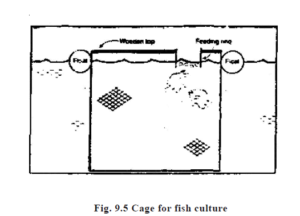
Small cages with mats of locally available plant materials such as palm leaves. Cyperus madre, Phragmites stem and split bamboo are used in India. These cages are of 1 – 2 m2 area. Split bamboos are joined with the help of coir rope or nylon twine. The cages are installed in the water body with bamboo supports at the four comers and the bottom. Materials other than bamboo mats are decayed by the third month and collapsed within a year. Split bamboo cages remain for over a year. Circular cages with thick bamboo stipes tied with nylon twine the durability of over 3 years.
Cages made up of monofilament woven material of 1 – 3 mm mesh size and 0.3 – 1 mm thickness are light and easy to handle, but remain for 6 to 12 months. The exposed part become brittle and gives way. Knotless nylon webbing of 3 – 6 mm mesh size and knotted nylon webbing of 7 -15 mm mesh have been found to be most durable. Cages made of water – proof surface painted light conduit pipe frames with a 10 m2 area are light in weight and have long durability. A battery of cages is enclosed with a bamboo catwalk and the whole structure floated by sealed empty barrels of 200 1. capacity.
The circular cages with conduit pipe structures which can be easily assembled have been designed with nylon webbing in different dimensions. These cages are floated freely on the water surface with the help of 3 – 4 sealed HDPP jerry cans. These arc extremely useful for cage culture. Due to their circular is shape the wave action in minimum. These can be moved from place to place with least water resistance. Due »their circular shape, the rearing space is maximum in side. The aeration and water circulation is better in these cages. Fishes can move in the cages with least obstruction.
Auto-floating, highly durable HDPP pipe frame nylon net cages with 36 m2 area are also used. These are light in weight and not need floats to float on the water surface.
The size of the cages depend on die scale of culture, species cultured, infraestructura, financial and management resources. The size varies from 2- 10m3 in India, 100 – 150m3 in Indonesia, 60- 180m3 in Kampuchia. 40 – 625 m3 in Vietnam and 30 m3 in Holland. Large cages are operated in Germany with 42 m diameter and 16, 500 m3 at the water depth of 12 m. These are provided with automatic or water jet pump-feeding, special handling and harvesting accessories.
California t ura B l mi pez mi s I norte C la edad s un D t h ei r sto C familiares gramo
The fishes used for the cage culture should be adaptable to captive culture, fast gro\vng, hardy and disease resistant. The Indian and Chinese carps, tilapia and magur can also be cultured where trash fish is cheaply and abundantly available. In Thailand and Kampuchia the cat fishes, Pangasius species are being cultured in cages successfully. Koi and Singhi are also cultured in India in cages.
En India, the nursery cages are stocked with carp fry at the range of 150-700 fry/in2 in caaes with different materials. In Japan 15.000-62.000 fry/nr2 of grass carp fry are stocked in nursery cages. The common carp stocking density is 150/nr2 in Kampuchia, 133 -417/nv1 in Indonesia and 80 – 360/nr2 in Vietnam. En Tailandia Pangasius sutchi, pag. larmmdi y pag. micronemus fry are stocked at densities of 150-300/ nr2 in cages of size 1-10 m2 area with a depth of 1.5m. .
The number of fish that can be stocked in a cage is variable and depends on the canying capacity of the water area, water quality and rate of circulation, the fish species, the quality and quantity of feed supplied. A safe level may be about 3000 to 6000 fish/ ha. In able – fish rearing cages in India, the fingerlings of carps are stocked at density of 30 – 38no /m2 . The tilapia, Oreochromis mossambicus can be stocked a rate of 100 – 200 m-2. Murrels can be stocked at density of 40-100m2.
Mamá norte ag mi hombres t un D y I el D
The cage culture can be taken up in two phases – nursery phase and table – fish rearing phase. In nursery phase of cage culture, the spawn or fry are reared to fingerling stage in 2-3 months. Different feeds can be used for culture in nursery cages. Groundnut oil cake, Salvado de arroz, egg yolk, soyabean cake, soyamilk and soya flour are used as food for fry in nursery cages. The silkworm pupae are also tried as supplementary food.
The initial size of fish to be stocked in the cages will depend primarily on the length of the growing season and the desired size at harvest. The carp fingerlings for stocking in 16-20 mm mesh cages should be over 10 gr. to expect a final size of over 500 gr. dentro de los 6 meses. It should be ensured that the fingerlings used for stocking are healthy and disease free. All the fish should be actively moving. It is ideal to stock cages in the cool part of the day.
En India, the growing season is almost year round, except for December – January in northern parts, where the temperature is low during these winter months. Very little natural food such as plankton, insects and various other organisms enter the cages and is available to fish. Sin embargo, supplementary feeding is essential in the cage culture to get high production. The types of feed used will depend on the species cultured and their prevailing market prices. Murrels, por ejemplo, require to be fed with fish, shrimps or other animal matter. Most of the fish cultured are omnivorous and they accept both plant and animal byproducts such as oilcakes, brans, fish meal and silk worm pupae.
Cage fish are generally fed at least once daily throughout the growing period to get better growth. The quantity of feed to be given is important, since under-feeding will reduce growth and production, while over-feeding will waste costly feed and can affect the water quality. A method used to estimate the daily feed to be give in cages is based on the total weight of the fish. The feed is usually expressed on percentage of body weight. In carps, the feeding rate is 4 – 5 % of the body weight per day until they attain approximately 100 gr. And thereafter at 2 – 3 %.
In table-fish rearing phase, involving the high-tech system of saturated stocking and feeding on enriched formulated feeds, the production recorded in common carp is 25 – 35 Kg m° month’1 in foreign countries. The channel catfish, Lactarius punctatus in USA yielded a production of 20 – 35 Kg/nr3. In Africa, tilapia yielded 17 Kg/nr3and trout produced 15 Kg/nr3. The food quotient in these cultures varied from 1.3 – 2.1. En India, a production of 1.5 – 2.5 Kg nr:month’1 common carp was achieved with mixed feed of silk worm pupae, ground cake and rice bran. Catla yielded 1.4 - 2.7 Kg nr2 month’1 with groundnut cake and rice bran with the food quotient 5.6. Tilapia produced 1 – 1.6 Kg nr2 month’1 with a mixture of rice bran, groundnut cake and commercial cattle feed and food quotient ranged from 1.8- 2.3 . About 1 Kg nr2 month”’ of murrel and 0.3 – 1.5 Kg nr2 month’1 of catfishes, singhi and Koi are obtained.
California gramo mi cu l tu re o F pr a wn s
The freshwater and marine prawns are also cultured in cages. The cages are stocked with wild or hatchery reared post larvae. Commercial scale rearing of post larvae in floating and fixed nursery cages (3.7 X 2.7 X 1.3 m) has been done with considerable success. They are fabricated from fine mesh (0.5 mm) nylon netting, supported by bamboo poles which are driven into the bottom of the water body. The optimal stocking density reported is 30, 000 post larvae/cage (2 .310 m’3). Feed is provided in trays fixed inside the cages. Inicialmente, the post larvae are fed on a paste of finely ground trash fish, later are fed with fresh mussel meat.
Educación física norte cultu r mi
Recent results in the use of cages, pens or enclosures and recirculating water systems suggest some ways of compact intensification of production in aquaculture given the accessory inputs. This practice may provide great possibilities in the future in certain selected and suitable areas.
Aquaculture in open waters through the use of pens or enclosures is also a means of minimising the limiting effect of metabolities and pollutants on cultivated stock. Greater production in very limited space has been found possible under those situations. Production figures from these types of aquaculture environments approximates to 4 -10 t/ha/yr in Laguna lake in Philippines.
Se l ectio norte o F s ite s fo r Educación física norte cultu re
i) Low tidal amplitude
ii) Fish pen – site must be sheltered as much as possible against high winds
iii) Depth not less than 1 meter during lowest water level
iv) The best site is on the leeward side of the prevailing winds with moderate flow of current especially in a place where current in overturning
v) Water with stable PH slight variation is best. Avoid turbid and polluted water.
vi) Muddy clay and clay – loam soils are best types of bottom soil. Too much still and decomposing organic matter must be avoided.
C ons t ruc t io norte o F pag en s
Pens can be constructed with the help of bamboo screens and nets
a . Co norte stru C tio norte o F pag mi norte s w I t h B a mbo o gritar mi norte s
Split bamboo should not necessarily be shaped and rounded. They are soaked in water for two weeks and then dried for one week. During the soaking and drying period, bamboo poles are prepared and staked at the chosen site according to thedesired size and shape of the fish pen. After stacking poles, bamboo splits are closely woven extending to a length of more or less five meters and made into a roll. After weaving, these are set by stretching them from one pole to the other interrurned or just set inside or outside close to the poles from bottom to top. They are tied every pole by rubber and one provided with sliced rubber around, liming one on top and one at the bottom. These splitted rubber prevent them from wear due to wave action. Nursery nets which should be 1/16 th to 1/10 th of the area of the fish pen can be set before constructing the fish pen or after it is set.
B C sobre s tr tu cti o norte o F pag mi norte Wisconsin t h norte et s
Construction of a fish pen made out of synthetic netting is easier than one made of bamboo screens. Netting materials can be kuralon, nylon, cremona, tamsi. etc. An ordinary fisherman can connect the nets into the fish.pen after taking into account the desired height or depth of the pen site. After the net is constructed , the poles are staked in mud after making a provision for the front rope and tie rope at the interval of 1.0 – 2.0 m per stake and also the provision for float rope. In preparing the poles, all nodes are cleaned except one node with brunch protending one inch which is staked in the mud from 15 – 30 cm or more depending upon the depth of soft mud. With this node the foot rope is tied, and these together with the bottom net are staked in the mud. Boulders can be used as sinkers in the absence of lead sinkers. Bamboo tips of 1-1 Vi m are also used to stake the bottom net with a foot rope firm into the mud to avoid escape of the fish stock. Construction of the nursery net may be done before or after the construction of the fish pen. They should have a free board of about 1 meter above the normal water level to prevent entry or exit of fishes by jumping and as a precaution against water level fluctuations. Metal and metal coated with HDPP screens are often used for pens which is highly durable.
Cu l tu re
Pen culture is extensively practiced in Japan, Peru and Philippines. Fish formers in Laguna debay and Sansabo Kekes stock milk fish fingerlings in pens and grow them to marketable size (200 g or above). Prawn are also similarly cultured. Very little work has been done on pen culture of fishes in India.
Traditional trapping and extensive culture of tiger prawn, milk fish, pearl spot, mullet, bekti and thread fins are done in some sort of pens and enclosures in canals joining the backwaters in Kerala and in the shallow areas of Chilka lake (Janos) in Orissa. The pens are made by weaving split bamboo or with netting. The enclosing of fishes is done usually after the monsoon season upto late autumn and the culture period lasts for about 6 to 8 months. The size of Janos in the Chilka lake varies from 5 to 500 ha. Since the stocking and harvesting are not done systematically, precise production S3* figures areajatavailable. The yield, sin embargo, is estimated to be about 60 Kg/ha/season.Seed rearing experiments were conducted in a split bamboo enclosure of 247.5 m2 reinforced with a nylon netting in Punarswamy Bhavanisagar (Tamilnadu). It was stocked with mrigal (size 7 mm) and Labeo fimbratus (size 5 mm) spawn at the rate of 4.6 million/ha and usual farm practices were followed. In 30 days mrigal attained a size of 38 mm and fimbriatus, 28 mm. At the time of conclusion of the study after 3 months, the former had attained a size of 88 mm and the later 75 mm. The overall survival obtained was 27.8 %.
Major carp seed rearing in pens is being done every year from 1982 onwards in the Tungabhadra reservoir in Karnataka. A shallow bay of the reservoir near Hampusagara is cordoned off with bamboo mats reinforced with Casuarina poles and lined with mononlament cloth during the summer months, prior to the reservoir getting filled. The pen is divided into several compartments with bamboo mats, lined with mononlament cloth. When the nursery pen, get water with the filling of reservoir, they are stocked with spawn of carps. The stocking density varies from 5 to 20 million spawn ha. The feed given is a mixture of ground nut cake and rice bran (1 :1). After 2 to 4 months the fingerlings
are enumerated and released in the reservoir. A supervivencia varying from 11 to 30 % is obtained from the varies nursery pens.
A pen culture experiment for raising cattle and rohu in Mamkamaun a flood plain lake in Gandak basic yields a computed production of 4/ ha/6 months. The experiment was conducted in a bamboo screen pen (1000m) and the stock was fed with a mixture of nee bran and mustard cake, apart from a feed formulated from the aquatic weeds collected from the lake. Since intrusion of fishes from outside including predators is possible in pens. It is important to stock larger fingerlings (over 50 g size) to ensure better survival. It is be desirable to have scale pen culture. The species mix and stocking rates will mainly depend on the natural food supply, supplemental feeding strategy, water depth and the duration of rearing.
Sorber pag lem mi nta r y F mi edi norte gramo
The fish pens that are densely stocked with 10-20 fish per square meter, generally need regular feeding at the rate of 4 -10 % of the total body weight of the stock at least once 3 week, or it could be divided into daily feeding. The amount of food to be given depends on the condition of the culture fish which could be checked through sampling at least once a month.
Gerentes t
Management offish pens is more laborious and demanding than a fish farm, because there are more risks in managing fish pens. Fingerlings are liable to escape once a single bamboo split breaks or a small portion of the net is torn. Every now and then the fish pens have to be checked for any holes or breaks.
The fish pen site has to be laid idle at least one month a year so that excess food and other organic matter are completely decomposed before stocking with new fingerlings. If the site is not sheltered it would be advisable to remove the net or split bamboo screen during the stormy season and repeat during fine weather condition.
S um metro Arkansas y
The culturable species of air breathing fishes are Fig. 9.1
C h a nn a s t r a eso tu s – Big or striped murrel or snake head fish
C Hann a punctatu s – Spotted murrel
Channa marulius – Giant murrel
Clarias batrachus – Magur
Heteropneustes fossilis – Singhi
Anabas testudineus – Koi or climbing perch.
Many species of trout are grown, but the three most common of them are the rainbow trout, Slamo gairdneri o Oncorynchus mykiss, the Eurorean brown trout, S.trutta (Fig. 9.2)and the brook trout, Salvelinus fontinalis. Trouts have a streamlined body, narrow gill openings and reduced gills. Trouts are adapted to highly oxygenated waters and freezing point temperatures. Trouts have great power of locomotion with clinging and burrowing habits. Mouth is modified with rasping lips for food collection from pebbles, rocas etc.
Sewage is a cloudy, dirty and odorous fluid from our toilets and kitchens of our houses. It has minerals and organic nutrients in a dissolved state or dispersed in a solid condition. Disposal of sewage has become a global problem because of urbanization. It is an effect of demophora, i.e. an unabated growth of human population. En años recientes, sewage has become a major pollutant of inland waters, especially rivers. It is a source of many epidemics. It is responsible for a serious threat to soil and water ecosystems. The approach towards waste water disposal should be utilization of this residue with the concept of their reuse or recycle through an ecologically balanced system involving mainly aquaculture. The utility of sewage effluent to enhance fertility of freshwater ponds has long been known in many countries of the world.
In our country, especially in rural areas, mere has been a tremendous growth of biogas plants as a source of non-conventional energy. Biogas is also called as gober gas. The biogas plant is a device for conversion of fermentable organic matter, especially cattle dung into combustible gas and fully matured organic manure or slurry by anaerobic fermentation. The nutrients of the generated slurry can be harvested for production of feed and food and replace conventional inorganic fertilizers. Biogas slurry enhances fish production.










